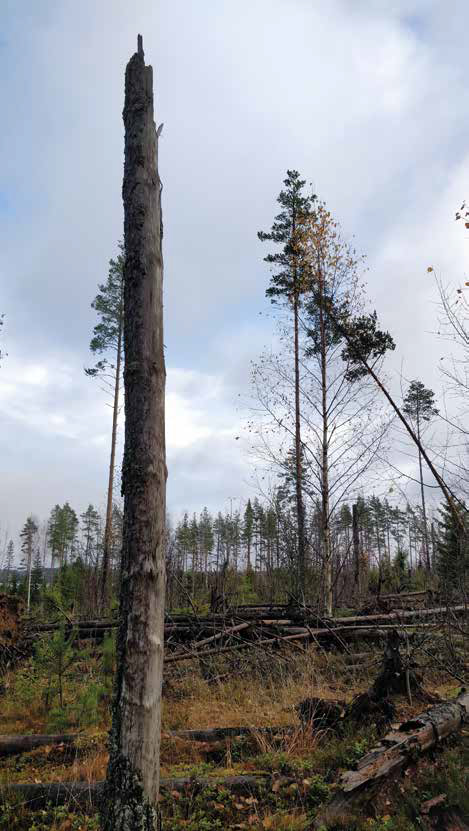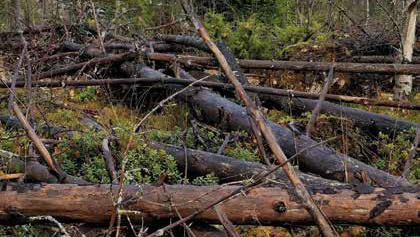The state-owned 105.8-hectare Äpätinkangas area lies in the village of Kekäleniemi in the municipal district of Rautjärvi. Äpätinkangas was granted nature reserve status by a government decree late in 2019. Äpätinkangas is unique because of the massive storm damage it suffered, which turned the area into the present natural forest disaster area containing abundant decayed wood. The ancient forests of Äpätinkangas were noteworthy even before the storm damage. On 29 July 2010, before midnight, the powerful downburst cluster of the storm Asta passed over Kekäleniemi. There are no similar downburst clusters reported in the history of Finnish weather phenomena.
The Kekäleniemi Village Association and Metsähallitus have jointly created a themed nature trail in Äpätinkangas. The trail is 1 km long and runs along an easy-access old forest track. You can traverse the trail on foot or by bicycle. The trail ends in a ridge-like sandy heathland formed during the Ice Age, which acts as watershed between two main waterways, the Hiitolanjoki and Vuoksi basins. The high point of the nature trail is its terminal, the forest type combining dry heathland forest and huge lying decaying trees. On this site, the damage caused by the storm Asta is visible and concrete, even tangible. At best, the various perceptions of the storm damage arena can be a dumbfounding event or an empowering experience. The picnic site at the terminal also offers fine views of Torsa. There are some guide boards placed along the trail, describing the importance of the area particularly as a living environment for species that depend on decaying wood. The visitor to the nature trail is also guided to examine their own relationship with the forest through a structured exercise.
The villagers needed to share their experiences and receive sympathy. However, those who overemphasised their own losses aroused anger. I steer clear of returning to the emotion. After all, my material losses were no more serious that a few bent bits of guttering. The social cohesion of the village was strengthened and the safety networks extended. In situations where the expected interaction included bemoaning the detached tin roof covering, I described my own experiences alongside my newborn baby. I knew that an attack by a legion of spruce bark beetles or stores running out of generators would not be my primary concerns. I even found myself being envious of those whose losses could be covered by insurance. Pity measured in cash would be somehow more concrete.
Everybody in our village was a victim of the storm. Expected values of the growth of the inherited forest or damage to a stand of young trees planted as a youth were among the most prominent factors for earning respect on emotional grounds. The collective grief of the village community was measured in the hectares flattened by the storm and the cubic metres of timber unfit for prime logs. The danger of misfortune hung in the air for a long time. Damage to health was caused only when the petrol-driven tools of energetic workers sang day and night on every headland. The garden lawns and flowerbeds had to be quickly restored to their former glory. Two concepts of time have become rooted in the speech of Kekäleniemi folk; there is the time before the storm and after the storm. We have a shared concern that traumatised many people for years. A trial that reinforces our village identity in a memorable way. A story to tell future generations.
It was a scorching hot day at the end of July. The warm, heavy air hung on the lower branches of the yard trees. I had trouble finding a birch to provide foliage shelter for a good and shady place to put your pale blue pram during your nap. You had been born in June, so we had a few weeks of living together behind us. You were my firstborn; we were still awestruck with each other. I felt unsure in my new role. The demands of the environment created expectations of best sources of nutrition for a newborn. They said that breastfeeding was so easy. My impaired confidence formed a knot in my mind. The norms of good motherhood created pressures.
I was tired from the heat of the day. I can’t remember any media warnings about strong winds or thunderstorms. On the other hand, I wouldn’t have done anything differently on the basis of a weather forecast. The garage doors were open and the trampoline in the garden, rain or shine. I tucked you in your cot for the night. The air conditioner hummed out cool air. I stretched out in my own bed, straightening out my slackened joints. The cool of the evening was already blowing in through the windows. Soon, raindrops on the tin roof blurred into a soothing murmur. Sleep arrived in no time.
The refreshing night breeze had turned into whistling. The howling made me get up. I closed and fastened the windows. The large windows looking out to the lake showed a grey landscape, lightnings flashed, I couldn’t make out the direction of the thunderclaps. The vista no longer had a discernible horizon, and the birch tree in the yard was hidden behind a wall of water. The window frames seemed to be coming loose with the rattling panes of glass. The tempest seemed to be forcing its way into the house. It is difficult to find words for the sounds of the storm. The ears perceived howling and roaring. On the other hand, all sounds had ceased. You could hear absolutely nothing. I can well understand the sense of bewilderment, if the residents of a house only became aware that a tree had crashed through the tin roof after the storm arena had passed.
You had caught my agitation. I picked you up from your cot, which was against the outside wall of the house. A few metres away from the brick wall stood the tallest spruce tree in our yard. I took you into my bed to continue your slumbers. The black tempest roared for a while longer, then swept furiously over us and went roaring on its way. It was useless counting the minutes; I could do nothing but wait. The night had taken charge, sleep had deserted me.

Curiosity over the damage to my yard made me get up. I stood on the steps of my home and felt like I had stepped outside in some other place. It was perfectly quiet. No summer’s night birds twittering or crickets whirring. Mist hung heavily a couple of metres above the fields. The earth was steaming. There was a smell of wet hay and soil. Tree trunks, exhausted by the storm, had snapped, throwing their splinters across the lawn. The tallest spruce in the yard had fallen away from the house, its slab of roots raised up like a wall. Garden furniture had been flung all over the yard. The trampoline was gone. Grass and leaves stuck on wet surfaces. I grieved for a moment over the fallen unripe apples and snapped soft fruit bushes. Overhead wires strung between power poles were sprawled on the ground, as were the poles. The village road was blocked by a trellis of fallen trees. Vehicle headlights looming through the mist swept along a field, seeking possible alternative routes, to somewhere.
Total exhaustion paralysed my ability to function. I knew the morning was too close. You called me to you again. At five o’clock, I was still trying to convert my feeling of powerlessness to something useful. I made mental lists of the locations of flashlights and disposable tableware in the house. Of the dairy products I had purchased yesterday and put in the warming fridge. I calculated whether the wet wipes would last through the next day. Fortunately, I didn’t know then that we would be 24 days without electricity and running water. The next day, I warmed formula milk for you in hot water on a camping stove. Even the birch that had shaded your nap was lying on the ground.
Text: Jenni Rautio
Pictures: Ninni Koponen
Translation: Annira Silver
Location on map
The story and the pictures are a part of Tarinajoki book (River of Stories), made in Rural Explorer project. As part of a culture tourism project, stories arising from the body of folk narratives and history also have a function in relation to the productisation of tourism. The stories are linked to real locations.
